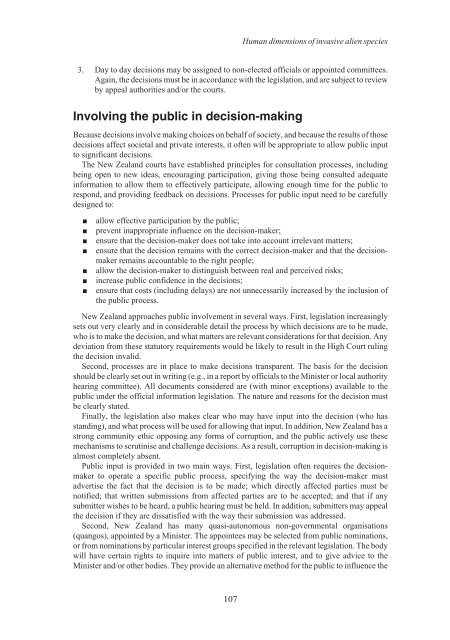Alien Species.vp - IUCN
Alien Species.vp - IUCN
Alien Species.vp - IUCN
Create successful ePaper yourself
Turn your PDF publications into a flip-book with our unique Google optimized e-Paper software.
3. Day to day decisions may be assigned to non-elected officials or appointed committees.<br />
Again, the decisions must be in accordance with the legislation, and are subject to review<br />
by appeal authorities and/or the courts.<br />
Involving the public in decision-making<br />
Because decisions involve making choices on behalf of society, and because the results of those<br />
decisions affect societal and private interests, it often will be appropriate to allow public input<br />
to significant decisions.<br />
The New Zealand courts have established principles for consultation processes, including<br />
being open to new ideas, encouraging participation, giving those being consulted adequate<br />
information to allow them to effectively participate, allowing enough time for the public to<br />
respond, and providing feedback on decisions. Processes for public input need to be carefully<br />
designed to:<br />
■ allow effective participation by the public;<br />
■ prevent inappropriate influence on the decision-maker;<br />
■ ensure that the decision-maker does not take into account irrelevant matters;<br />
■ ensure that the decision remains with the correct decision-maker and that the decisionmaker<br />
remains accountable to the right people;<br />
■ allow the decision-maker to distinguish between real and perceived risks;<br />
■ increase public confidence in the decisions;<br />
■ ensure that costs (including delays) are not unnecessarily increased by the inclusion of<br />
the public process.<br />
New Zealand approaches public involvement in several ways. First, legislation increasingly<br />
sets out very clearly and in considerable detail the process by which decisions are to be made,<br />
who is to make the decision, and what matters are relevant considerations for that decision. Any<br />
deviation from these statutory requirements would be likely to result in the High Court ruling<br />
the decision invalid.<br />
Second, processes are in place to make decisions transparent. The basis for the decision<br />
should be clearly set out in writing (e.g., in a report by officials to the Minister or local authority<br />
hearing committee). All documents considered are (with minor exceptions) available to the<br />
public under the official information legislation. The nature and reasons for the decision must<br />
be clearly stated.<br />
Finally, the legislation also makes clear who may have input into the decision (who has<br />
standing), and what process will be used for allowing that input. In addition, New Zealand has a<br />
strong community ethic opposing any forms of corruption, and the public actively use these<br />
mechanisms to scrutinise and challenge decisions. As a result, corruption in decision-making is<br />
almost completely absent.<br />
Public input is provided in two main ways. First, legislation often requires the decisionmaker<br />
to operate a specific public process, specifying the way the decision-maker must<br />
advertise the fact that the decision is to be made; which directly affected parties must be<br />
notified; that written submissions from affected parties are to be accepted; and that if any<br />
submitter wishes to be heard, a public hearing must be held. In addition, submitters may appeal<br />
the decision if they are dissatisfied with the way their submission was addressed.<br />
Second, New Zealand has many quasi-autonomous non-governmental organisations<br />
(quangos), appointed by a Minister. The appointees may be selected from public nominations,<br />
or from nominations by particular interest groups specified in the relevant legislation. The body<br />
will have certain rights to inquire into matters of public interest, and to give advice to the<br />
Minister and/or other bodies. They provide an alternative method for the public to influence the<br />
107<br />
Human dimensions of invasive alien species












